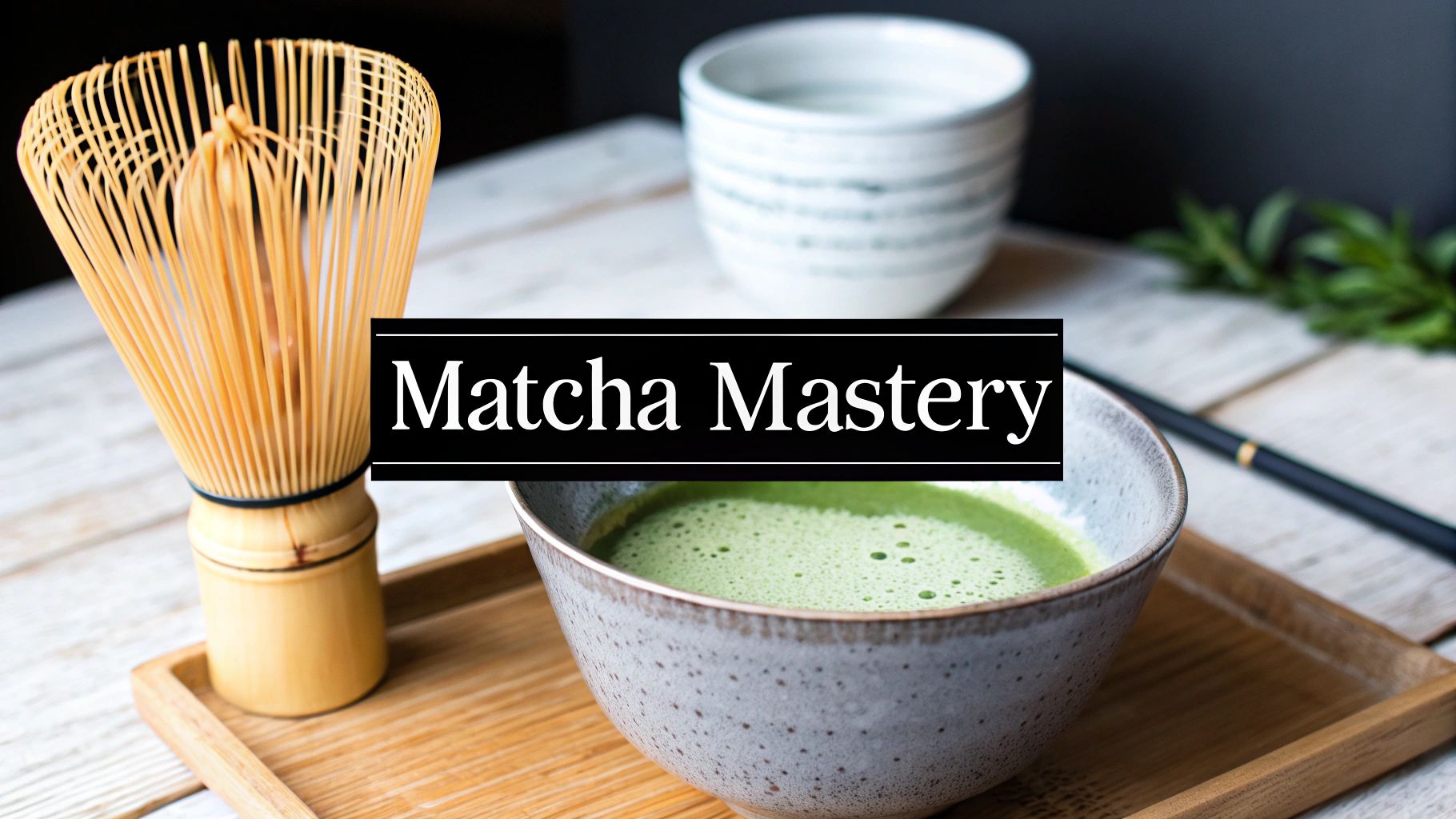When you think of preparing authentic matcha, the one tool that's absolutely non-negotiable is the traditional bamboo whisk, or chasen. It’s not just for show; this beautifully crafted utensil is the secret to unlocking the perfect cup. Its fine, delicate tines are specifically designed to whip the tea, creating that signature creamy froth that you simply can't get with a spoon or a standard kitchen whisk.
Why Your Whisk Matters More Than You Think
Ever tried just stirring matcha powder into water? You probably ended up with a lumpy, disappointing brew. This is where the chasen proves its worth. It’s a brilliant piece of traditional engineering. Those 80-plus flexible tines are designed to do two things at once: suspend the fine tea particles evenly throughout the water and whip air into the mixture.
This action is what creates that beautiful, velvety layer of microfoam on top. It’s this foam that releases the matcha's full, complex aroma and its deep, savoury umami flavour.
Honestly, using the right tool is just as important as the quality of your matcha powder.
- A metal whisk can actually react with the tea, tainting its delicate flavour profile.
- An electric frother might seem like a quick fix, but it creates large, airy bubbles that collapse in seconds, rather than the stable, creamy foam you want.
The bamboo whisk, on the other hand, respects the tea and the tradition, delivering the experience as it was intended. This is especially true when you're working with a high-quality powder like Amatsu Matcha's Pure blend, where you want to appreciate every single nuance.
We're seeing a huge return to these traditional methods, and it's no surprise. Here in the UK, the focus on wellness is fuelling incredible growth in the matcha market. Projections show it more than doubling from around USD 340 million in 2025 to nearly USD 790 million by 2031. It seems we're all rediscovering the benefits of a proper cup of tea.
Getting the hang of this simple tool is a game-changer. It elevates your daily matcha from just a drink to a genuinely mindful and satisfying ritual. You’re not just making tea; you’re connecting with a centuries-old practice, creating a moment of calm in your day.
Choosing the right tools is the first step to an authentic experience. Of course, the source of your tea is just as critical. To see why, you can learn more about what makes for exceptional organic matcha from Japan.
How to Choose the Right Matcha Bamboo Whisk
When you’re first starting out with matcha, picking the right bamboo whisk, or chasen, can seem a bit daunting. But it really boils down to one key thing: the number of prongs, or what we call the tine count. This single detail has a huge impact on the final texture and froth of your matcha.
It's all about how you like your tea. A whisk with around 80 tines is a fantastic all-rounder, especially if you're new to the game or prefer a thicker, richer matcha style called koicha. Its sturdy prongs are great at breaking down the matcha powder into a perfectly smooth paste, making it ideal for a focused, traditional experience with our Pure or Shrooms blends.
On the other hand, if you’re dreaming of a light, frothy matcha latte (usucha), you'll want a whisk with 100 to 120 tines. More prongs mean more air is whipped into the tea, creating that beautiful, delicate microfoam on top. This is the perfect partner for our Radiance blend.
Understanding Quality and Craftsmanship
Once you've decided on the tine count, take a closer look at the craftsmanship. A genuinely well-made chasen will have prongs that are evenly spaced and curl gently inwards at the tips. The central knot that binds it all together should be tight and secure. It’s normal for it to loosen just a touch after its first soak, but it should never look like it's about to unravel.
These little details are what separate a good whisk from a great one. A quality chasen not only performs better but will also stand the test of time, ensuring you get the most out of every serving of Amatsu Matcha.
Investing in the right tools is key because it helps you get the most out of every single cup. Just look at the difference between matcha and regular green tea.
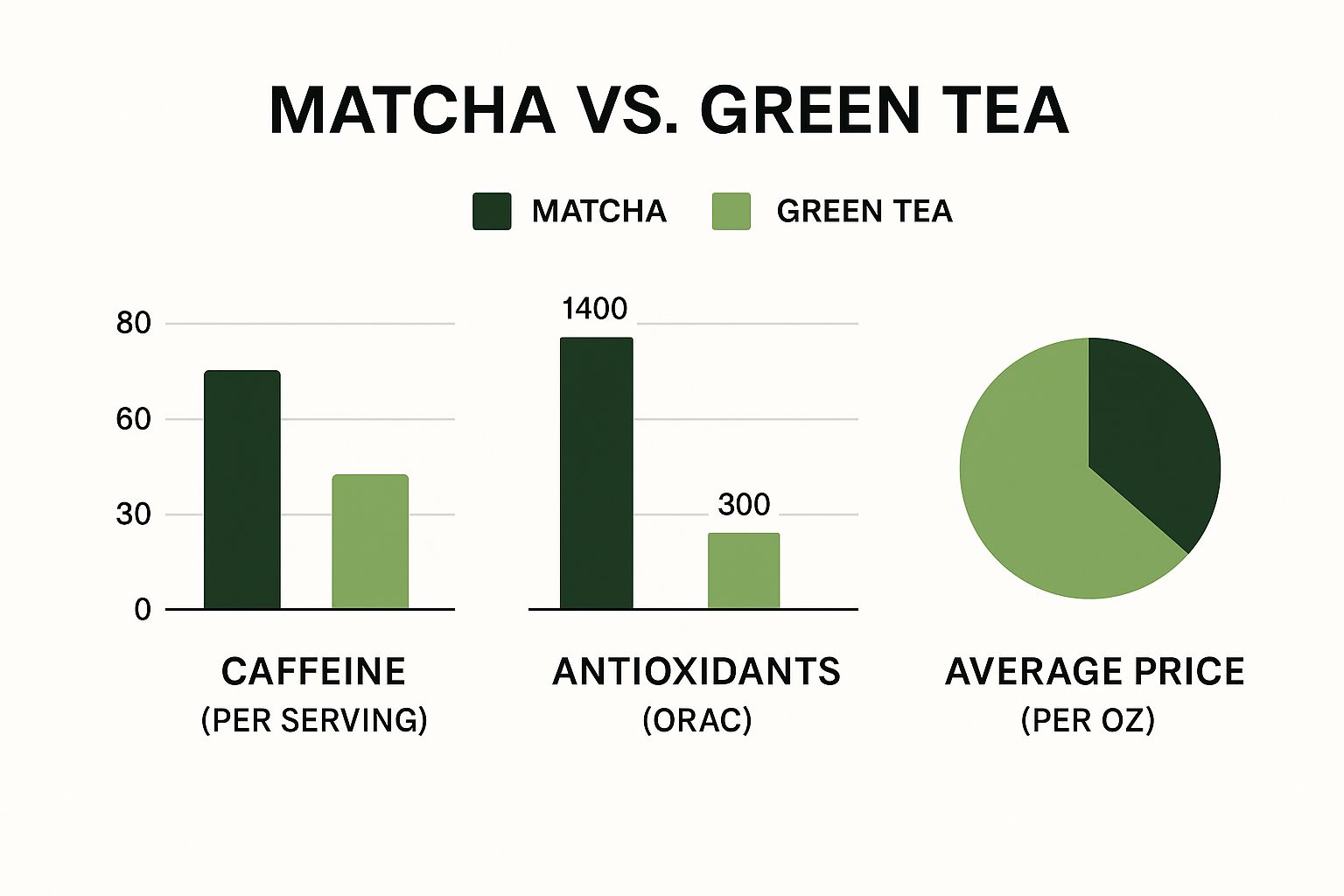
As you can see, you’re getting a much bigger hit of antioxidants and flavour with matcha, so you want to prepare it properly.
With the growing interest in Japanese wellness culture here in the UK, more people are appreciating the value of authentic tools. A proper chasen is a small work of art, traditionally handcrafted from a single piece of bamboo. It’s amazing to think it's carefully split into dozens of fine tines, all to create that signature frothy texture. To learn more about how all the tools come together, have a look at our guide to the tea ceremony at home.
Matcha Whisk Comparison: The Tine Count Guide
To make it even clearer, here’s a quick breakdown of how different tine counts perform. Use this table to match a whisk to your personal matcha ritual.
| Tine Count | Best For | Resulting Froth | Ideal User |
|---|---|---|---|
| ~80 | Koicha (thick tea) & traditional bowls | Rich and creamy, less foam | Amatsu Pure & Shrooms drinkers |
| ~100 | Usucha (thin tea), Lattes | Light, delicate microfoam | Amatsu Radiance & Strength drinkers |
| ~120 | Usucha (thin tea) | Very fine, airy, voluminous foam | Froth enthusiasts, experts |
Ultimately, choosing your whisk is a personal decision. Think about the kind of matcha you’ll be making most often.
For a creamy, daily latte with Amatsu Matcha's Radiance blend, a 100-prong whisk is my go-to. But for a more intense, traditional bowl of our Pure matcha that really centres you, an 80-prong whisk is perfect.
The Art of Whisking for a Perfect Froth
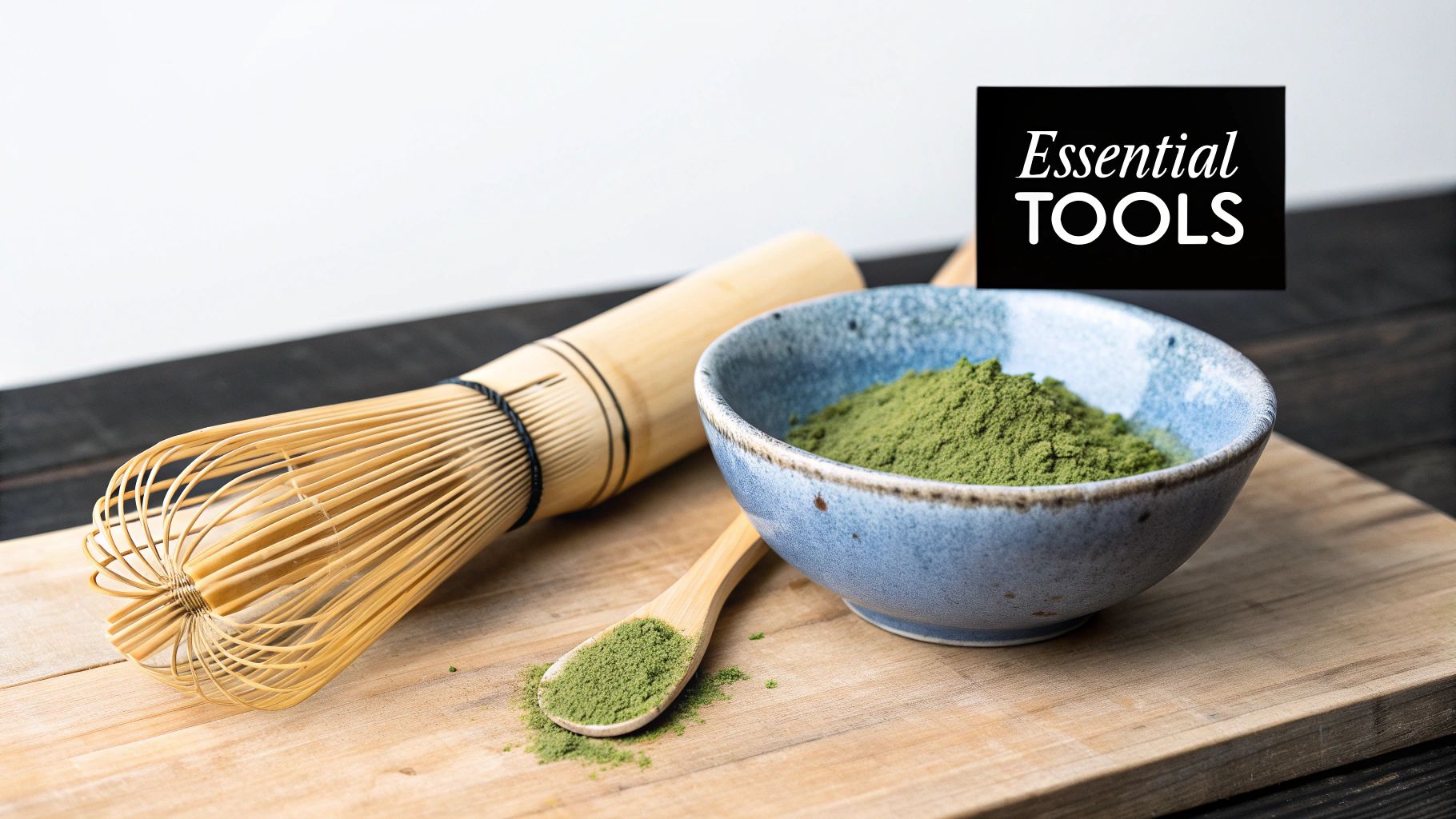
This is where the real magic happens. It’s time to take that vibrant green powder and transform it into a perfectly suspended, creamy bowl of matcha. If you've ever had clumpy, bitter tea, you know how disappointing it can be. The secret to a smooth, satisfying experience every single time is all in the wrist—and your bamboo whisk is the star of the show.
Before you even think about adding the matcha, your whisk needs a little TLC. Giving the delicate bamboo tines a quick soak in warm water for about a minute is a non-negotiable first step. This makes them pliable and soft, which not only prevents them from snapping mid-whisk but also helps them whip up a much finer froth.
Another little ritual that makes a world of difference is sifting. Pushing your Amatsu Matcha powder through a fine-mesh sieve might feel like an extra fuss, but it’s the only way to guarantee a lump-free, silky-smooth finish. Trust me, it’s the secret weapon against those dreaded clumps at the bottom of your bowl.
Mastering the Motion
Now for the main event: the whisking motion. Many newcomers make the classic mistake of stirring in slow circles, as if they were mixing sugar into a cup of tea. This will only move the powder around; it won’t create that beautiful suspension or the rich froth we're aiming for.
The proper technique is a rapid motion that comes entirely from your wrist, not your arm. You want to trace a quick 'M' or 'W' shape back and forth across the bowl. It's this vigorous, zigzag movement that really aerates the tea and creates that coveted layer of delicate microfoam.
Don’t be too gentle here. The idea is to agitate the water and matcha together as quickly as you can. A good whisking will produce a uniform layer of tiny bubbles across the surface, giving the matcha its signature creamy, velvety texture.
Of course, the quality of your powder plays a massive part. A high-grade ceremonial powder like Amatsu Matcha has finer particles that suspend more easily in water, resulting in a more stable and delicious froth that truly holds its structure. This is what enhances both the flavour and the entire experience. It's no surprise that powdered matcha is by far the most popular format in the UK, accounting for over 55% of market revenue.
Getting this technique down might take a bit of practice, but the payoff is a truly exceptional bowl of matcha. For a more detailed walkthrough of the entire ritual, have a look at our complete guide on how to whisk matcha.
Proper Care to Extend Your Whisk’s Lifespan
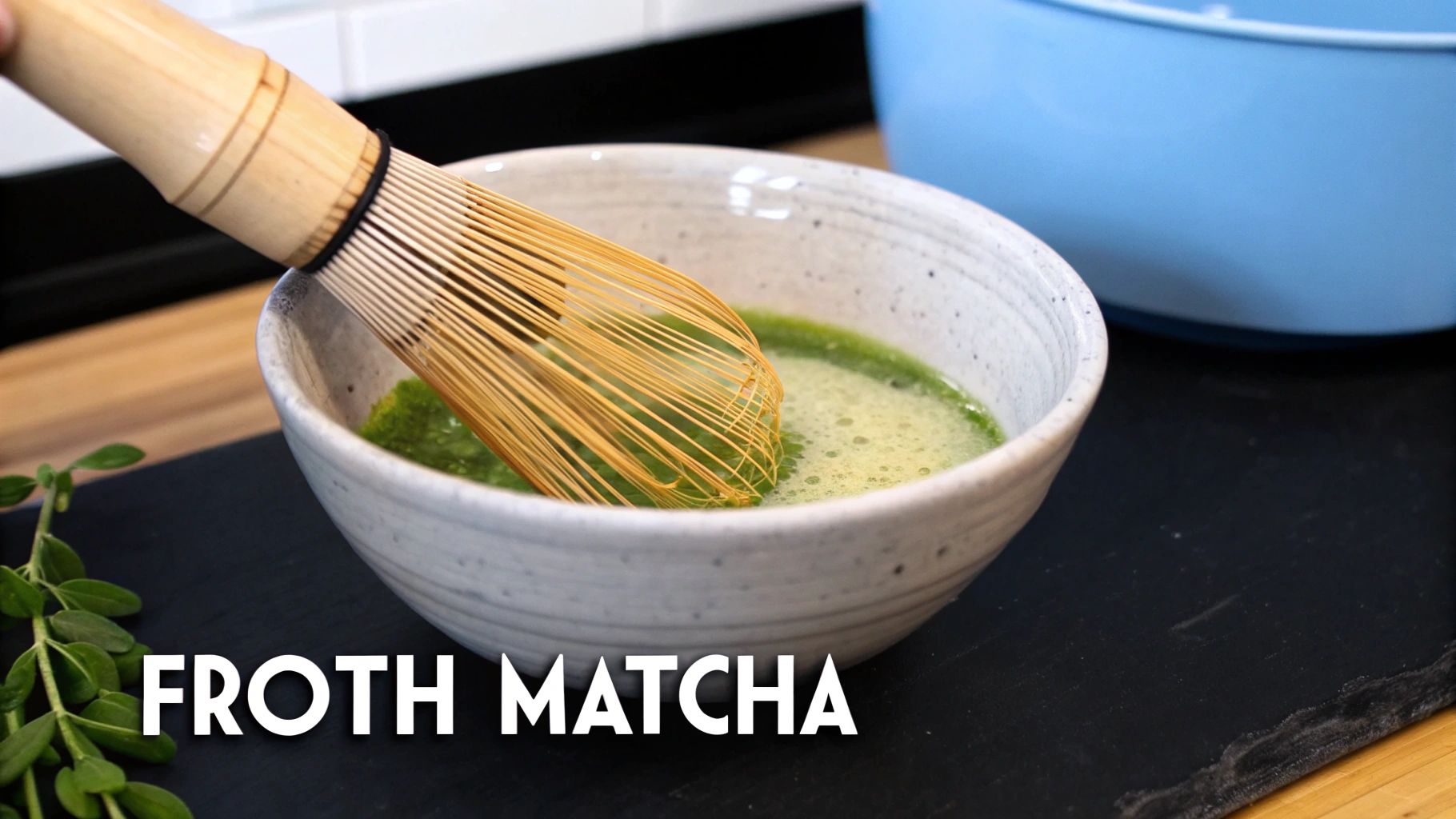
A bamboo whisk is a pretty resilient tool, but like any piece of fine craftsmanship, it really thrives with the right care. A little bit of attention after each use is all it takes to turn it from a temporary accessory into a long-term partner in your matcha ritual. This simple habit will help you get that perfect froth for your Amatsu Matcha for months, or even years.
The golden rule, and the most important one to remember, is this: no soap and no dishwashers. They're far too aggressive for natural bamboo. The harsh detergents can strip the wood of its natural oils, making the tines brittle, and you’ll almost certainly be left with a soapy residue that will spoil the flavour of your next cup.
Instead, cleaning should be a gentle, almost mindful practice. Right after you’ve finished whisking your matcha, just rinse the tines thoroughly under a stream of warm—not boiling—water. Give it a gentle swirl under the tap to make sure any lingering tea particles are washed away. If you feel it needs a bit more of a clean, you can let it stand in a bowl of warm water for a minute or so before the final rinse.
The Secret To Maintaining Its Shape
This is the part where so many people trip up. Once your whisk is clean, please don't just stand it up on its base or toss it into a cutlery drawer. That's the fastest way I've seen to flatten the delicate tines and destroy the curve that’s so crucial for whipping up a good foam.
Honestly, the single best investment you can make for your matcha green tea bamboo whisk is a ceramic holder, known as a kusenaoshi. Popping your damp whisk onto one of these after cleaning does two incredibly important things:
- It preserves the shape: The kusenaoshi is specifically designed to maintain that signature outward curl of the tines, keeping them perfectly fanned out for effective whisking.
- It ensures proper drying: Air can circulate freely around every single tine, which prevents moisture from getting trapped. This is key to stopping mould and mildew before they even have a chance to start.
Think of the kusenaoci as a custom-made armchair for your whisk. It gives it the support it needs to rest and recover, making sure it’s in prime condition for its next performance. Taking this one small step will dramatically extend its lifespan.
Finally, just keep an eye out for natural wear and tear. Over time, you might notice a few tines have snapped off or the tips have worn down significantly. When this happens, it’s a clear sign you need a replacement. A damaged whisk just can’t create the same quality of froth, no matter how good your technique is.
For a deeper dive into the world of traditional tea, why not explore our guide to authentic Japanese tea and matcha?
Creative Ways to Use Your Matcha Whisk
While your bamboo whisk is the undisputed champion of preparing traditional tea, its utility doesn't end there. Think of it less as a single-purpose tool and more as a secret weapon for any modern, health-conscious kitchen. Its true talent lies in bringing a silky-smooth texture to all sorts of matcha creations.
A fantastic way to incorporate your whisk into daily life is by making concentrated matcha shots. This isn't about sitting down for a full, ceremonial bowl. Instead, you're crafting a small, potent, and perfectly smooth base that can be used in countless other recipes.
Making a Modern Matcha Shot
The technique is simple. Take about one teaspoon of your favourite Amatsu Matcha blend and whisk it vigorously with just 30-40ml of hot water. Using that same quick 'M' or 'W' motion you've perfected for your tea, you'll whip up a thick, vibrant, and beautifully frothy liquid in seconds. This little shot is the perfect foundation for lattes, iced drinks, and even some surprisingly sophisticated cocktails.
It’s an especially brilliant way to use our functional blends:
- For a pre-workout boost: Whisk up a quick shot of our Strength blend and pour it over iced water for a clean, energising drink.
- For a beauty-focused latte: A shot of our Radiance blend combined with frothed oat milk makes for a creamy and nourishing start to your day.
- For enhanced focus: A traditional shot of our Shrooms blend combines the power of matcha with brain-boosting Lion's Mane and Chaga.
This method ensures every last particle of matcha is dissolved and aerated before it meets other ingredients. The result? A guaranteed clump-free, café-quality drink, every single time.
By using your matcha green tea bamboo whisk to create these shots, you're really unlocking its full potential. To brush up on the fundamentals, you can always revisit our complete guide on how to prepare matcha tea.
Your Matcha Whisk Questions Answered
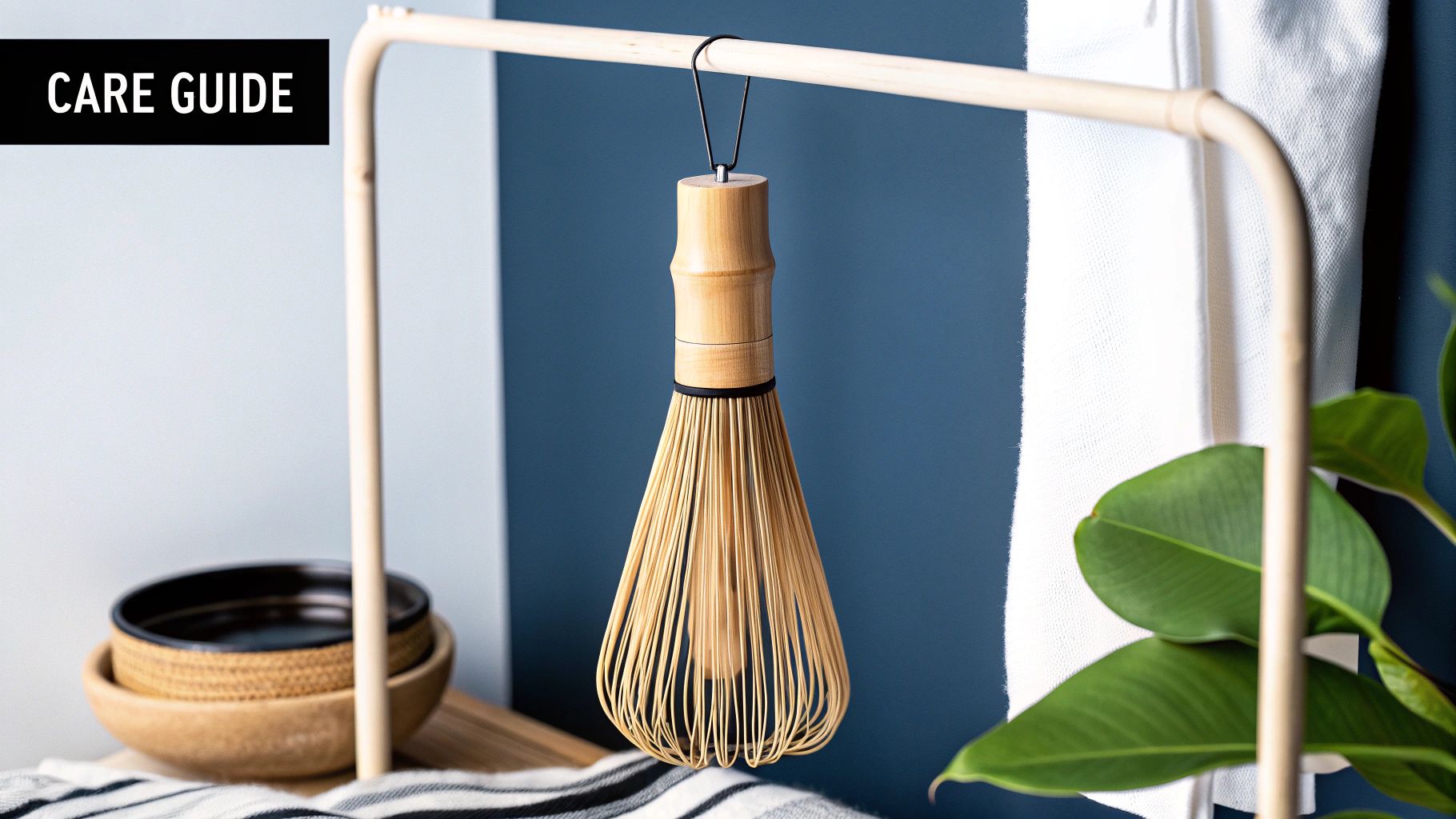
Even when you have the right tools, a few questions are bound to pop up. Let's walk through some of the most common queries we get about the matcha green tea bamboo whisk so you can feel completely confident in your daily ritual.
A very common concern, especially with a new whisk, is about the central knot. People often worry when they see the black thread loosen or even start to unravel after a few uses. Don't panic! This is not only normal, but it's actually supposed to happen.
The knot is tied tightly just for shipping. As you use it, the knot relaxes and the tines "bloom" or open up. This allows the delicate bamboo tines the space they need to flex and whisk effectively. Think of it as a sign of a well-made chasen, not a flaw.
Common Whisking Questions
"Can I just use something else?" This is probably the number one question I hear. It's tempting to reach for a small metal kitchen whisk or an electric milk frother, but you simply won't get the same result.
Here’s the breakdown on why substitutes don't quite work:
- Metal whisks can sometimes react with the tea, which can subtly taint the matcha’s delicate, grassy flavour.
- Electric frothers are too aggressive. They whip up large, unstable bubbles that disappear in seconds, failing to create the velvety, stable microfoam a chasen is known for.
The traditional bamboo whisk is the only tool that can properly suspend the fine tea particles in the water while gently aerating it. This specific action is what creates that signature texture and unlocks the full umami flavour of high-quality matcha.
A frequent point of confusion is knowing when to replace your whisk. The tell-tale signs are when you notice several of the tines have snapped off or the tips look frayed and worn down. A damaged whisk just can't create that beautiful froth, so getting a new one is key to a perfect cup.
And what about that little ceramic stand, the kusenaoshi? Do you really need one? We can't recommend it enough. It's a small investment that protects your most important matcha tool. It allows your whisk to air dry thoroughly in its proper shape, which prevents mould and significantly extends its life.
Ready to create your own perfect bowl of matcha? Explore the exceptional quality of Amatsu Matcha and discover how our premium ceremonial and functional blends can elevate your daily ritual. Find your perfect match at amatsumatcha.com.
Read more
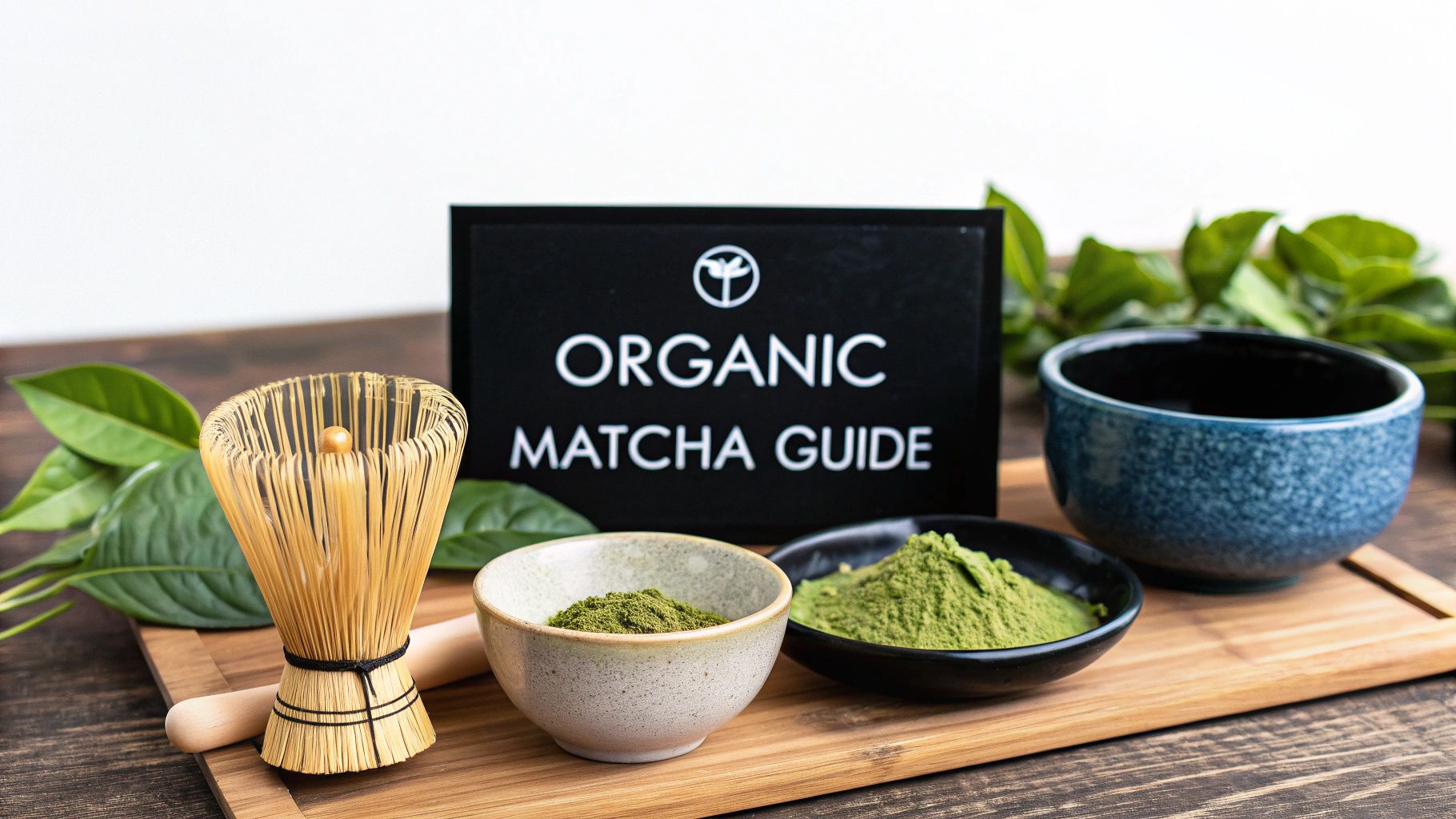
Discover authentic organic matcha from Japan. This guide explores how to choose quality matcha, its health benefits, and brewing secrets for the perfect cup.
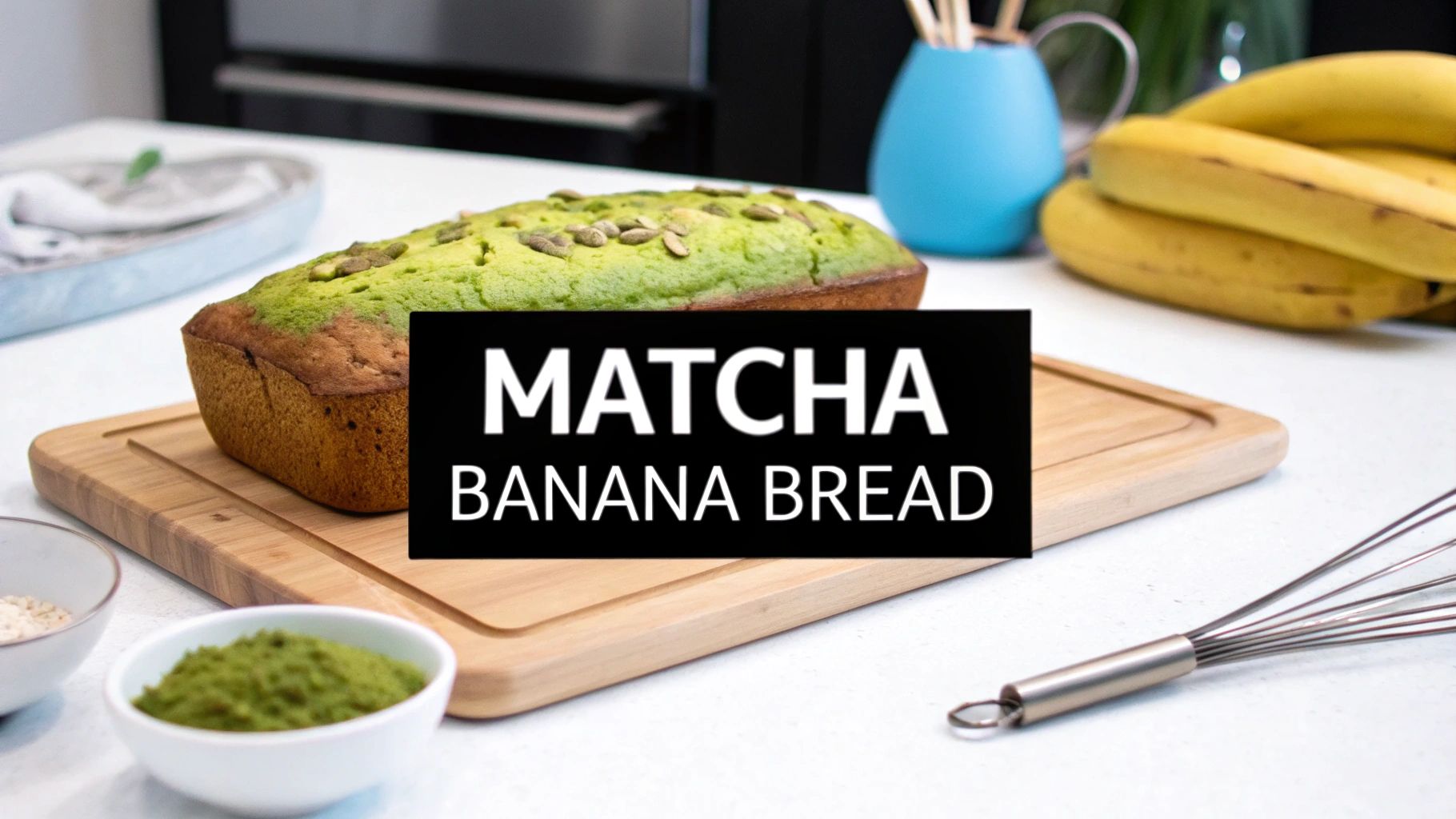
Bake the best matcha banana bread with this easy, foolproof recipe. Learn how to get a moist crumb, vibrant green color, and delicious flavor every bake.
